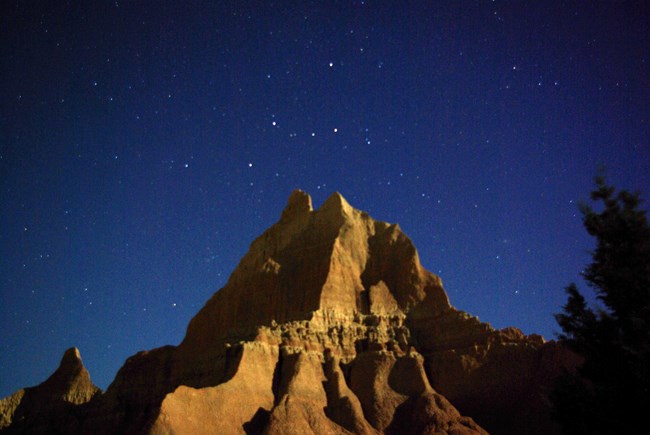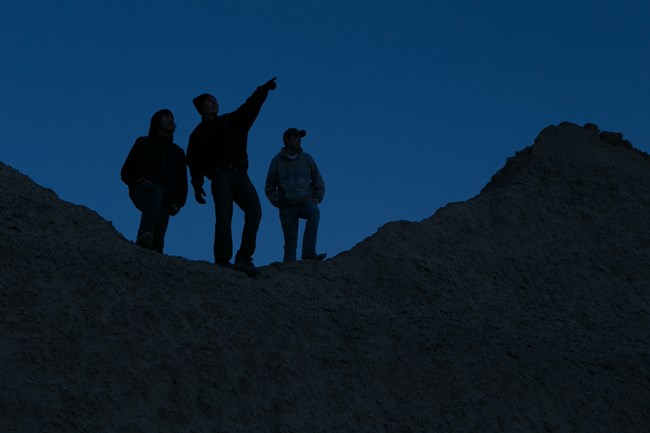Last updated: October 15, 2024
Article
Night Skies: Beyond the Badlands

NPS Photo

NPS Photo
Why is Badlands National Park a great place to stargaze?
Visitors who experience the park after dark can see many different things in the night sky. Badlands National Park is a relatively remote park with very little light pollution. Light pollution is when excess artificial light (like streetlamps, advertising, illuminated stadiums, or anything else that produces light at night) brightens the night sky. When the night sky is brightened in this way, nighttime ecosystems are disrupted and seeing the stars is difficult.
Light pollution creates challenges for many animals and plants. Prey animals often rely on darkness to hide from predators, and without it, they are left exposed. Birds that migrate using the moon and stars to navigate can become disoriented. Many birds die from flying directly into buildings, misdirected by artificial light. Insects attracted to light gather around streetlamps, where many get injured, exhausted, or eaten by a predator. Light pollution makes the days seem longer and the nights seem shorter, taking away valuable hunting time from nocturnal predators like bats.
Because Badlands National Park is not surrounded by big cities or other major sources of light pollution, night skies in the park are very clear. After dark, visitors can see many of the night sky’s greatest hits: constellations, the moon, satellites, and airplanes. But the special darkness of Badlands National Park helps visitors to see even more like planets, the Milky Way, star clusters, nebulae, the International Space Station, shooting stars, and – very occasionally – the aurora borealis.

NPS Photo
What can I see in the night sky at the Badlands?
Great question! There are a lot of amazing sights in our night skies for you to enjoy on their beauty alone, but understanding the science behind them makes these sights even more special.
-
The Moon: You probably already know the moon, but where did it come from? Scientists theorize that around 4.45 billion years ago, a small planet may have collided with Earth. When it did, bits of the Earth and the colliding planet were thrown into space. Over time, this material stuck together to form the moon!
-
Planets: Do you know the planets of our solar system? In order from the closest to the sun to the most distant, they are: Mercury, Venus, Earth, Mars, Jupiter, Saturn, Uranus, and Neptune. While the planets we see at the Badlands vary year to year, in the past, visitors have seen Venus, Mars, and Jupiter. Some have been lucky enough to see these planets through the 11-inch Celestron telescopes available at our Night Sky Viewings!
-
Shooting stars/meteors: Believe it or not, a shooting star has nothing to do with an actual star! A “shooting star” is when space material falls into the Earth’s atmosphere and burning up. Shooting stars are also known as meteors, and if they hit the Earth’s surface, they are known as meteorites.
-
The Milky Way: The Milky Way, which we see as a cloudy band of light and stars in the night sky, is our home galaxy. A galaxy is a collection of stars, gas, and dust that are all held together by gravity. Every star that we see in the night sky is a part of our own Milky Way Galaxy. Did you know that there are more stars in the sky than grains of sand on Earth?
-
The International Space Station: The International Space Station (or ISS) is a large spacecraft that orbits Earth and is home to the astronauts who live and work in space. The ISS was built and is used by many different nations. These nations’ astronauts have the opportunity to research space science. The ISS orbits the Earth every 90 minutes and can be seen regularly in the night sky.

NPS Photo
Where can I learn about the night skies at the Badlands?
Badlands National Park offers stargazing events called Night Sky Viewings every night in the summer. At these viewings, park rangers and volunteers use powerful laser pointers to show and describe different constellations, planets, and other objects in the night sky. During these viewings, rangers will also help you use the park’s 11-inch Celestron telescopes. Junior Rangers who pick up a Night Explorer Junior Ranger Booklet from the Ben Reifel Visitor Center during the day can also complete their activity booklet and earn their Night Explorer Junior Ranger Badge during this program.
The time of this program changes based on the time of the sunset, but it typically follows the Evening Program for the night. Why not catch both? During evening programs, rangers will give a 30-45 minute program on the topic of their choice (past program topics have included bison, paleontology, bighorn sheep, National Parks trivia, and many others). After that, you can unwind and enjoy the Night Sky Viewing with astronomy volunteers and rangers.
The Badlands also hosts an annual AstroFest, in which park visitors and astronomy experts gather to celebrate the night sky. By day, various programs will be available to learn about the sky and sun using telescopes and other scientific tools. In the past, these activities have included guest speakers, planetarium shows, equipment demonstrations, and static displays. At night, space science professionals will join Badlands volunteers and park rangers to assist visitors in a star viewing.
